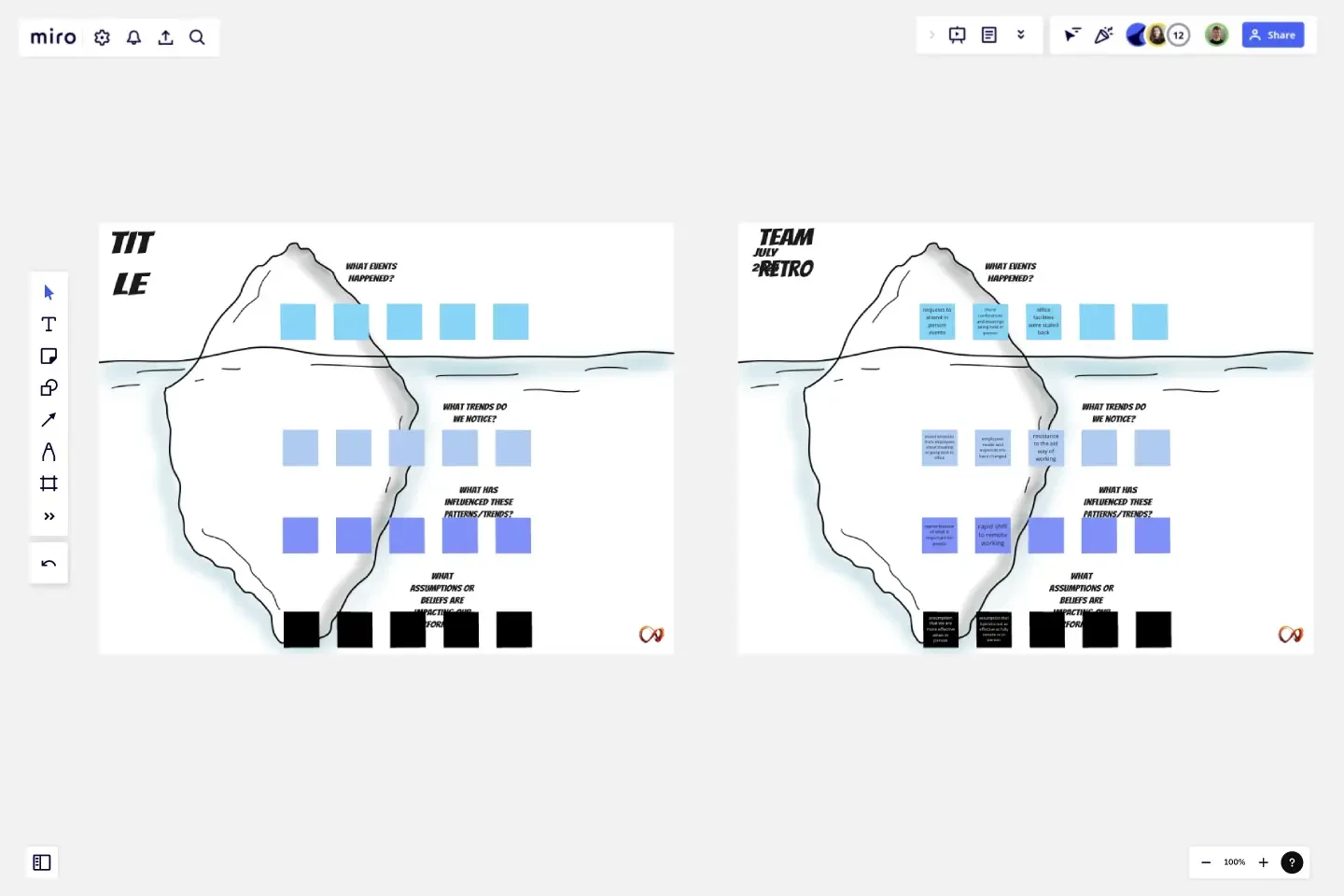Iceberg Reflection
This handdrawn canvas using the metaphor of an iceberg is digging deeper and getting below what is on the surface of what is happening. After all 85% of the icebergs lies below the surface of the water.
This canvas is an engaging and fun way to get a team reflecting on their performance and looking for root causes. It helps ensure that everyone gets heard and alignment is created.
When to Use the Canvas?
As a leader or facilitator there are key moments in a team's journey when a deeper reflection and regrouping are required. Use this canvas at these touch points. This may be scheduled periodically to support moving from forming, storming, norming and performing (Bruce Tuckman's team development model) or when you notice team behaviors require an intervention.
This canvas is particularly helpful when you realize that limiting mindsets and assumptions are getting in the way of the team's progress.
Why Use It?
Because handdrawn elements bring a whimsical and fun energy into work, and who couldn't use more of that on a day to day basis?! Plus no one ever complained of too much alignment or shared understanding in a team.
How to Use It?
The prompt questions in this template support reflection and reconnection. The prompt questions in this canvas are borrowed from Systems Thinking.
(Original source of the iceberg model is believed to be Anthropologist Edward T. Hall)
These prompt questions are suggestions, feel free to change these prompts to support the conversation you want to have with your team.
Start by focusing on the events that happened, then move to the trends, what is influencing these trends and down to the underlying assumptions impacting performance.
This template could also be used during change programs and/or in team or personal coaching conversations. Other versions of the iceberg model have been used to explore organizational culture.
Have fun and let the lighthearted spirit of the canvas ignite inspiration and creativity!
This template was created by Island Inspirations.
Get started with this template right now.
SAFe Roam Board
Works best for:
Agile Methodology, Operations, Agile Workflows
A SAFe ROAM Board is a framework for making risks visible. It gives you and your team a shared space to notice and highlight risks, so they don’t get ignored. The ROAM Board helps everyone consider the likelihood and impact of risks, and decide which risks are low priority versus high priority. The underlying principles of SAFe (Scaled Agile Framework) are: drive cost-effective solutions, apply systems thinking, assume that things will change, build incrementally, base milestones on evaluating working systems, and visualize and limit works in progress.
Design Sprint Kit Template
Works best for:
Agile Methodology, UX Design, Sprint Planning
With the right focused and strategic approach, five days is all it takes to address your biggest product challenges. That’s the thinking behind Design Sprint methodology. Created by Tanya Junell of Blue Label Labs, this Design Sprint Kit provides a set of lightweight templates that support the Design Sprint’s collaborative activities and voting—and maintains the energy, team spirit, and momentum that was sparked in the session. Virtual sprint supplies and prepared whiteboards make this kit especially useful for remote Design Sprint Facilitators.
PI Planning Template
Works best for:
PI Planning, Product Management
The Miro PI Planning Template streamlines the Program Increment planning process for Agile teams. It facilitates a collaborative environment, enabling teams to efficiently align on strategies, identify dependencies, and convert decisions into actionable tasks. With features like real-time collaboration, Jira integration, and a centralized workspace, the template supports teams in enhancing efficiency, engagement, and decision-making.
Startup Canvas Template
Works best for:
Leadership, Documentation, Strategic Planning
A Startup Canvas helps founders express and map out a new business idea in a less formal format than a traditional business plan. Startup Canvases are a useful visual map for founders who want to judge their new business idea’s strengths and weaknesses. This Canvas can be used as a framework to quickly articulate your business idea’s value proposition, problem, solution, market, team, marketing channels, customer segment, external risks, and Key Performance Indicators. By articulating factors like success, viability, vision, and value to the customer, founders can make a concise case for why a new product or service should exist and get funded.
Features Prioritization Tool
Works best for:
Agile
The Features Prioritization Tool offers a systematic approach to prioritizing product features based on criteria such as value, effort, and strategic alignment. It provides a structured framework for capturing, evaluating, and ranking feature ideas, enabling teams to make informed decisions about what to build next. With customizable scoring mechanisms and visual dashboards, this template empowers product teams to optimize their product roadmap and deliver maximum value to customers, driving competitiveness and market success.
SAFe PI Planning
Works best for:
Agile
SAFe PI Planning is a collaborative event for Agile Release Trains to plan and align on program increments. It provides a structured framework for setting objectives, identifying dependencies, and sequencing work. This template facilitates PI Planning sessions, enabling teams to visualize their commitments and coordinate cross-team dependencies effectively. By promoting transparency and alignment, SAFe PI Planning empowers Agile organizations to deliver value at scale with predictability and quality.
